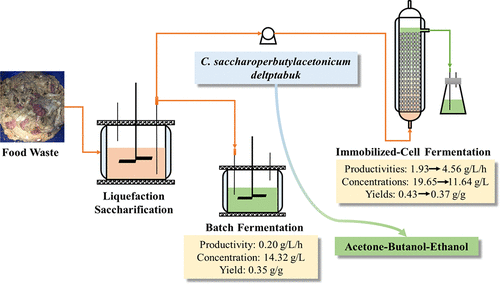当前位置:
X-MOL 学术
›
ACS Sustain. Chem. Eng.
›
论文详情
Our official English website, www.x-mol.net, welcomes your
feedback! (Note: you will need to create a separate account there.)
High Acetone-Butanol-Ethanol Production from Food Waste by Recombinant Clostridium saccharoperbutylacetonicum in Batch and Continuous Immobilized-Cell Fermentation
ACS Sustainable Chemistry & Engineering ( IF 7.1 ) Pub Date : 2020-06-08 , DOI: 10.1021/acssuschemeng.0c02529 Qing Jin 1 , Zhaohui An 2 , Ashok Damle 3 , Nicholas Poe 1 , Jian Wu 1 , Hengjian Wang 1 , Zhiwu Wang 2 , Haibo Huang 1
ACS Sustainable Chemistry & Engineering ( IF 7.1 ) Pub Date : 2020-06-08 , DOI: 10.1021/acssuschemeng.0c02529 Qing Jin 1 , Zhaohui An 2 , Ashok Damle 3 , Nicholas Poe 1 , Jian Wu 1 , Hengjian Wang 1 , Zhiwu Wang 2 , Haibo Huang 1
Affiliation

|
Sustainable and economical production of butanol via acetone-butanol-ethanol (ABE) fermentation faces several major challenges, including high feedstock cost, low butanol yield, and low butanol productivity. To address these challenges, low-cost food waste was used as feedstock for ABE production in batch and continuous immobilized-cell fermentation by a recombinant high-butanol production strain Clostridium saccharoperbutylacetonicum deltptabuk. Food waste was first liquefied and saccharified to obtain fermentable sugars. After that, food waste hydrolysates were fed into both batch and continuous immobilized-cell fermentation systems to produce ABE. In the batch fermentation, only 14.32 g/L ABE was produced using food waste hydrolysates medium. However, when food waste hydrolysate medium was fed into the continuous immobilized-cell fermentation, remarkable increases of ABE production, yield, and productivity were achieved. At the dilution rate of 0.1 h–1, 19.65 g/L ABE was produced with an ABE yield of 0.43. At the dilution rate of 0.39 h–1, the highest ABE productivity (4.56 g/L/h) was obtained, which was 23 times higher than that in the batch fermentation. This study for the first time demonstrated efficient conversion of food waste to butanol via continuous immobilized-cell fermentation to achieve high titer and productivity, which would potentially support the advanced utilization of organic waste materials for biofuel production.
中文翻译:

分批重组连续糖胞发酵和固定化发酵从食物垃圾中大量生产丙酮-丁醇-乙醇
通过丙酮-丁醇-乙醇(ABE)发酵可持续且经济地生产丁醇面临数项主要挑战,包括原料成本高,丁醇收率低和丁醇生产率低。为了应对这些挑战,低成本的食品垃圾被用作重组高丁醇生产菌株梭状芽孢梭菌(Clostridium saccharoperbutylacetonicum deltptabuk)批量生产和连续固定细胞发酵的原料,用于ABE生产。首先将食物垃圾液化并糖化以获得可发酵的糖。之后,将食物残渣水解产物送入分批和连续固定细胞发酵系统中以生产ABE。在分批发酵中,使用食物残渣水解产物培养基仅生产14.32 g / L ABE。然而,当将食物废水解产物培养基加入到连续的固定细胞发酵中时,ABE的产量,产量和生产率得到了显着提高。在0.1 h –1的稀释率下,生产的ABE为19.65 g / L,ABE的产率为0.43。稀释率为0.39 h –1,获得了最高的ABE生产率(4.56 g / L / h),是分批发酵的23倍。这项研究首次证明,通过连续的固定化细胞发酵,可将食物残渣有效地转化为丁醇,从而实现高滴定度和生产率,这有可能支持有机废物原料在生物燃料生产中的先进利用。
更新日期:2020-07-06
中文翻译:

分批重组连续糖胞发酵和固定化发酵从食物垃圾中大量生产丙酮-丁醇-乙醇
通过丙酮-丁醇-乙醇(ABE)发酵可持续且经济地生产丁醇面临数项主要挑战,包括原料成本高,丁醇收率低和丁醇生产率低。为了应对这些挑战,低成本的食品垃圾被用作重组高丁醇生产菌株梭状芽孢梭菌(Clostridium saccharoperbutylacetonicum deltptabuk)批量生产和连续固定细胞发酵的原料,用于ABE生产。首先将食物垃圾液化并糖化以获得可发酵的糖。之后,将食物残渣水解产物送入分批和连续固定细胞发酵系统中以生产ABE。在分批发酵中,使用食物残渣水解产物培养基仅生产14.32 g / L ABE。然而,当将食物废水解产物培养基加入到连续的固定细胞发酵中时,ABE的产量,产量和生产率得到了显着提高。在0.1 h –1的稀释率下,生产的ABE为19.65 g / L,ABE的产率为0.43。稀释率为0.39 h –1,获得了最高的ABE生产率(4.56 g / L / h),是分批发酵的23倍。这项研究首次证明,通过连续的固定化细胞发酵,可将食物残渣有效地转化为丁醇,从而实现高滴定度和生产率,这有可能支持有机废物原料在生物燃料生产中的先进利用。





















































 京公网安备 11010802027423号
京公网安备 11010802027423号